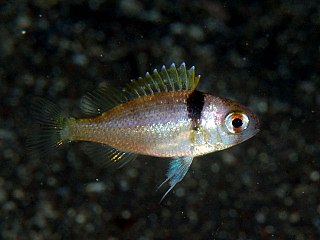
Scolopsis bilineata, the two-lined monocle bream, bridled monocle bream, bridled spinecheek, double-lined coral bream or yellow-finned spine-cheek, is a species of marine ray-finned fish belonging to the family Nemipteridae, the threadfin breams. This species is found in the to the Indian and Western Pacific Oceans.

Scolopsis is a genus of marine ray-finned fishes belonging to the family Nemipteridae, the threadfin breams. These fishes are found in the Indian Ocean and the western Pacific Ocean.

Nemipterus is a genus of marine ray-finned fishes belonging to the family Nemipteridae, the threadfin and whiptail breams. These fishes are found in the Indian and Pacific Oceans, but now also occur in the Mediterranean Sea due to Lessepsian migration.

Parascolopsis, the dwarf monocle breams, is a genus of marine ray-finned fishes belonging to the family Nemipteridae, the threadfin breams. These fishes are found in the Indo-Pacific region.

Scaevius is a monotypic genus of marine ray-finned fish belonging to the family Nemipteridae, the threadfin breams. The only species in the genus is Scaevius milii, the green-striped coral bream, the coral monocle bream or jurgen, is found in Australia.

Scolopsis margaritifera, the pearly monocle bream or pearly spinecheek, is a species of marine ray-finned fish belonging to the family Nemipteridae, the threadfin breams. This fish is found in the marginally in the eastern Indian Ocean and in the western Pacific Ocean.

Scolopsis ciliata, the saw-jawed monocle bream, ciliate spinecheek, silver-line spinecheek or whitestreak monocle bream is a species of marine ray-finned fish belonging to the family Nemipteridae, the threadfin breams. This fish is found in the Indian and Pacific Oceans.

Scolopsis affinis, the Peters' monocle bream, bridled monocle bream or yellowtail spinecheek, is a species of marine ray-finned fish belonging to the family Nemipteridae, the threadfin breams. This species is found in the to the Indian and Western Pacific Oceans.

Pentapodus setosus, the butterfly whiptail, is a species of marine ray-finned fish belonging to the family Nemipteridae, the threadfin breams. This fish is found in the Western Central Pacific Ocean.

Parascolopsis eriomma, the rosy dwarf monocle bream, is a species of marine ray-finned fish belonging to the family Nemipteridae, the threadfin breams. This species is found in the Indian and Western Pacific Oceans.
Nemipterus isacanthus, the teardrop threadfin bream or twinlined threadfin bream, is a species of marine ray-finned fish belonging to the family Nemipteridae, the threadfin and whiptail breams. This fish is found in the western Pacific Ocean.
Parascolopsis tanyactis, the saddled dwarf monocle bream, longray monocle bream or yellowbellied monocle bream, is a species of marine ray-finned fish belonging to the family Nemipteridae, the threadfin breams. This fish is found in the Eastern Indian Ocean and the Western Pacific Ocean.
Parascolopsis rufomaculata, the red-spot dwarf monocle bream or yellowband monocle bream, is a species of marine ray-finned fish belonging to the family Nemipteridae, the threadfin breams. This species is found in the eastern Indian Ocean.

Parascolopsis capitinis, the large-head threadfin bream is a species of marine ray-finned fish belonging to the family Nemipteridae, the threadfin breams. This species is found in the western Indian Ocean.
Parascolopsis baranesi, also known as Baranes’s dwarf monocle bream, is a species of marine ray-finned fish belonging to the family Nemipteridae, the threadfin breams. This fish is endemic to the Gulf of Aqaba in the western Indian Ocean.
Parascolopsis melanophrys, the dwarf monocle bream, is a species of marine ray-finned fish belonging to the family Nemipteridae, the threadfin breams. This species is found in the western-central Pacific Ocean.
Parascolopsis qantasi, the slender dwarf monocle bream, is a species of marine ray-finned fish belonging to the family Nemipteridae, the threadfin breams. This fish is found in the eastern Indian Ocean.
Parascolopsis townsendi, the scaly dwarf monocle bream, is a species of marine ray-finned fish in the family Nemipteridae, the threadfin breams. It is found in the western Indian Ocean.

Pentapodus vitta , the Western whiptail, Western butterfish, black stripe butterfish, striped whiptail or Western threadfin bream, is a species of marine ray-finned fish belonging to the family Nemipteridae, the threadfin breams. This fish is found in the Eastern Indian Ocean.

Scolopsis vosmeri, also known as Vosmaer's monocle bream, white-banded monocle bream, whitecheek monoclebream and whiteband spinecheek, is a species of marine ray-finned fish belonging to the family Nemipteridae, the threadfin breams. This species occurs in the eastern Indian Ocean and western Pacific Ocean.













